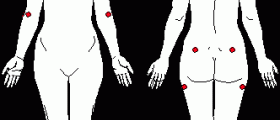
There are a lot of people who suffer from fibromyalgia all over the world. Fibromyalgia is a syndrome of chronic pain and stiffness that spreads throughput the tissues which support and move joints and bones. Some of the most common symptoms of this disorder are fatigue, muscle pain and tender points. In most cases fibromyalgia occurs alone but in some cases it is accompanied by arthritis, osteoarthritis and lupus. In the United States more than 5% of all people suffer from fibromyalgia. Fibromyalgia can happen to anyone but it is mostly the women who suffer from it and especially women of age between 20 and 65. The symptoms of this disorder are very similar to those of chronic fatigue syndrome. People with fibromyalgia usually complain about the pain in neck, shoulder, upper and lower back and hip areas.
Causes and risk factors of fibromyalgia
No one knows for sure what triggers fibromyalgia but there are a lot of theories about the causes. A complication of hypothyroidism, rheumatoid arthritis and sleep apnea can all lead to fibromyalgia.One of the theories claims that sleep disturbance can cause fibromyalgia. Most people with this disorder cannot have a good night’s sleep because their most restful stage of sleep is usually disturbed or interrupted. Because of that a person might be lacking a certain growth hormone which is responsible for muscle repair and maintenance.
Symptoms of fibromyalgia
There are certain symptoms that point out to fibromyalgia. One of the most common is widespread muscular and joint pain for a long period of time. This pain can be located in one place but it can appear in several locations at once. Apart from this, a person may experience severe tenderness in certain tender points, lack of proper sleep and fatigue. Fatigue usually occurs due to the lack of sleep. Experts say that there are no less than 18 tender points on the body where pain caused by fibromyalgia may occur.
A person may experience these symptoms because of various factors like stress, anxiety, depression, hormonal changes and even change in weather.
Diagnosis of fibromyalgia
A person cannot undergo a blood or x-ray in order for the doctor to diagnose fibromyalgia. The diagnosis is made on clinical findings and medical history of the patient. In most cases a person will suffer from this disorder for a long period of time but fibromyalgia will not progress. There is no way a person can directly treat fibromyalgia but he or she can get to know the symptoms and try to avoid them. Regular exercises and enough sleep help a lot in these cases. A person can ask the doctor about taking certain medications as well. Stress should be avoided as well.



-vs-Trigger-Points-(Myofascial-Pain-Syndrome)_f_280x120.jpg)













Your thoughts on this
Loading...